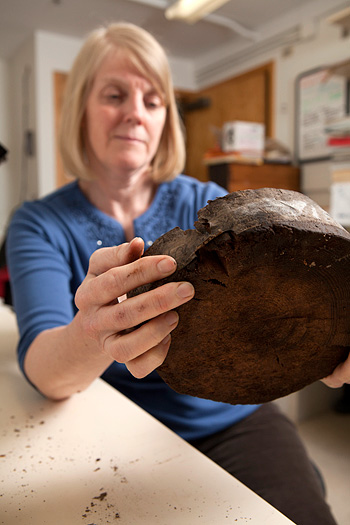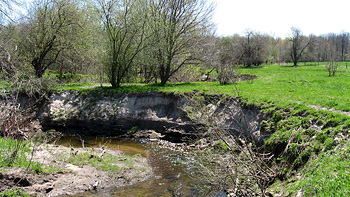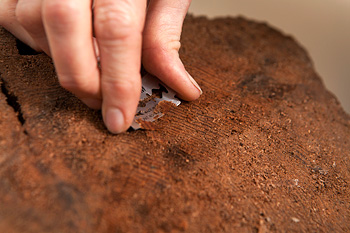
Carol Griggs '77, Ph.D. '06, a research associate and lab manager for Cornell's Dendro Lab, examines a sample from a 12,000-year-old tree to choose the best radius for ring-width measurements. Photo by Lindsay France/University Photography.
Carol Griggs '77, Ph.D. '06, Cornell's Dendro Lab manager, finds clues to climate change in ancient wood
The scene is straight out of a disaster movie: melting glaciers wreaking havoc on the ecosystem, and a tundra-like wasteland where once forest reigned. Thirteen thousand years ago or so the spruces, firs and birches of central New York state vanished; dendrochronology researcher Carol Griggs '77, Ph.D. '06, is using ancient wood to figure out what happened when they finally reappeared.
Griggs has been working on and off in the Cornell Tree-Ring Laboratory, home to the Malcolm and Carolyn Wiener Laboratory for Aegean and Near Eastern Dendrochronology, since her days as an undergraduate archaeology major. Now a research associate and also the lab manager, she started the New York state and N.E. North American Dendrochronology Project at the Dendro Lab as part of her graduate geology work.
In 2008, a farmer's call led Griggs to a jackpot of old logs sticking out from a stream bank. In three days, she and her volunteers were able to collect useable wood samples from 80 logs, which turned out to be 9,000 to 12,000 years old, dating from the end of the Younger Dryas to the beginning of the warmer Holocene (the current geological era).

The logs sticking out of the banks of this creek grew anywhere from 6,000 to 12,000 years ago. The logs show evidence of a riverine environment, not much different than what it is today, but much colder. The oldest samples are mainly spruce, a dominant species in boreal forests. Photo provided by Todd Grote.
But Griggs also found evidence of a puzzle: an extremely abrupt drop in temperature near the end of the Younger Dryas era. The climate shift lasted approximately 50 years, much longer than could be accounted for by normal weather conditions. According to Griggs, this sudden dip in temperature must have been due to a large-scale event affecting the North Atlantic region. Figuring out what that event was could shed light on what to expect from the current period of climate change.
"The dip means colder water or colder air getting into this area," Griggs says. "The question is why."

Carol Griggs '77, Ph.D. '06.
Data about changing temperatures and precipitation patterns can be extracted from wood using both tree ring growth width patterns as well as stable isotope analysis of the wood, explains Charlotte Pearson, research associate and lab supervisor. "For trees growing in environments where conditions are tough, a tiny change in climate can make a big difference in growth, so we look at stressed trees that document those changes over time."
One possibility Griggs has considered for the 50-year temperature drop is based on evidence that salt concentration of the inland Champlain Sea decreased around this time. Perhaps glacial melt caused some of the seawater to spill into Lake Ontario, changing both the salt concentration in the water as well as its temperature. There's some evidence for this, though Griggs cautions that more data is needed before it's clear whether the dip was caused by glacial water coming in and cooling off the area.
With glaciers now melting again and sea levels rising around the world, Griggs says it's conceivable that the events she sees embedded in the ancient wood could happen again.

Griggs prepares a sample from a tree that grew approximately 12,000 years ago. Photo by Lindsay France/University Photography.
In addition to the New York project, Griggs is part of a Dendro Lab team studying an old Istanbul harbor. The wooden posts left in the harbor are filling in a long-standing gap in the tree-ring record for the first millennium A.D. in Constantinople, providing a vital resource for dating in the region. According to Pearson, the Dendro Lab's analysis is so sensitive that researchers can sometimes identify both the year and the exact season in which the wood was cut.
Griggs has reconstructed the climate of the Aegean region from the present all the way back to 1086 A.D., and she plans to continue building chronologies with climatic information, one tree ring sample at a time.
Linda B. Glaser is staff writer for the College of Arts and Sciences.